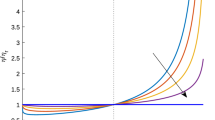Abstract
There are now many theoretical explanations for why Benford’s law of digit bias surfaces in so many diverse fields and data sets. After briefly reviewing some of these, we discuss in detail recurrence relations. As these are discrete analogues of differential equations and model a variety of real world phenomena, they provide an important source of systems to test for Benfordness. Previous work showed that fixed depth recurrences with constant coefficients are Benford modulo some technical assumptions which are usually met; we briefly review that theory and then prove some new results extending to the case of linear recurrence relations with non-constant coefficients. We prove that, for certain families of functions f and g, a sequence generated by a recurrence relation of the form \(a_{n+1} = f(n)a_n + g(n)a_{n-1}\) is Benford for all initial values. The proof proceeds by parameterizing the coefficients to obtain a recurrence relation of lower degree, and then converting to a new parameter space. From there we show that for suitable choices of f and g where f(n) is nondecreasing and \(g(n)/f(n)^2 \rightarrow 0\) as \(n \rightarrow \infty \), the main term dominates and the behavior is equivalent to equidistribution problems previously studied. We also describe the results of generalizing further to higher-degree recurrence relations and multiplicative recurrence relations with non-constant coefficients, as well as the important case when f and g are values of random variables.
Similar content being viewed by others
Notes
If \(\log _{10} 2\) equals p/q then \(2 = 10^{p/q}\), so \(2^{q-p} = 5^p\) and thus \(p = q-p = 0\), which is impossible.
We are using big-Oh notation: \(f(x) = O(g(x))\) at infinity if there exists an \(x_0\) and a \(C>0\) such that for all \(x \ge x_0\) we have \(|f(x)| \le C g(x)\); it is big-Oh at zero if instead it is true for all \(x \le x_0\).
Unlike our case, for roots of polynomials this process breaks down for degree five and higher.
These functions are not uniquely determined by f, g; however, they are completely determined by a choice of \(\lambda (1)\).
As in Lemma 3.4, these functions are not unique, but are completely determined by \(\lambda (1), \lambda (2)\).
Generalizing the recurrence relation of Fibonacci k-step numbers, the authors proved the recursive sequence \(x_n = \prod _{i=1}^{k} x_{n-i}\) to be Benford. Each term \(x_n\) (\(n>k\)) is the product of powers of \(x_1, \cdots , x_k\) with Fibonacci k-step numbers as the exponents.
References
Benford F (1938) The law of anomalous numbers. Proc Am Philos Soc 78:551–572
Berger A, Bunimovich Leonid A, Hill T (2005) One-dimensional dynamical systems and Benford’s law. Trans Am Math Soc 357(1):197–219
Berger A, Hill TP (2009) Benford Online Bibliography. http://www.benfordonline.net
Berger A, Hill TP (2015) An introduction to Benford’s law. Princeton University Press, Princeton
Corazza M, Ellero A, Zorzi A (2008)What sequences obey Benford’s law? Working Papers from Department of Applied Mathematics, University of Venice, No. 185
Diaconis P (1977) The distribution of leading digits and uniform distribution Mod 1. Ann Probab 5(1):72–81
Goldberg S (1961) Introduction to difference equations. Wiley, London
Hill T (1996) The first-digit phenomenon. Am Sci 86:358–363
Jang D, Kang JU, Kruckman A, Kudo J, Miller SJ (2009) Chains of distributions, hierarchical Bayesian models and Benford’s law. J Algebra Number Theory Adv Appl 1(1):37–60
Kontorovich A, Miller SJ (2005) Benford’s Law, Values of \(L\)-functions and the \(3x + 1\) Problem. Acta Arithmetica 120:269–297
Miller SJ, Takloo-Bighash R (2006) An invitation to modern number theory. Princeton University Press, Princeton
Miller SJ (2015) Benford’s Law: theory and applications. Princeton University Press, Princeton
Nagasaka K, Shiue J (1987) Benford’s law for linear recurrence sequences. Tsukuba J Math 11(2):341–351
Romano PK, Mclaughlin H (2011) On non-linear recursive sequences and Benford’s law. Fibonacci Q 49:134–138
Tao T (2010) 254B, Notes 1: Equidistribution of polynomial sequences in tori 254A. https://terrytao.wordpress.com/2010/03/28/254b-notes-1-equidistribution-of-polynomial-sequences-in-torii/
Acknowledgements
Much of the analysis was done during the 2018 Williams College SMALL REU Program, and we are grateful to our colleagues there, as well as to participants of the Conference on Benford’s Law Application in Stresa, Italy, for helpful comments, and to the referees whose detailed comments improved the exposition.
Author information
Authors and Affiliations
Corresponding author
Additional information
Publisher's Note
Springer Nature remains neutral with regard to jurisdictional claims in published maps and institutional affiliations.
Electronic supplementary material
Below is the link to the electronic supplementary material.
Rights and permissions
About this article
Cite this article
Farris, M., Luntzlara, N., Miller, S.J. et al. Recurrence relations and Benford’s law. Stat Methods Appl 30, 797–817 (2021). https://doi.org/10.1007/s10260-020-00547-1
Accepted:
Published:
Issue Date:
DOI: https://doi.org/10.1007/s10260-020-00547-1




